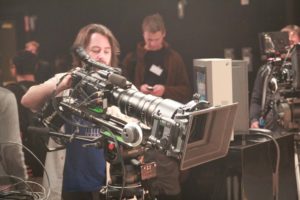Those of us who spend way too much time on camera technology websites and travel the major industry tradeshow circuit like to think we’re always one step ahead. We traffic in substantiated rumors and informed speculation. We don’t guess at what’s coming next – well, some of us do. Many of us thought we knew what to expect from Sony’s Super 35mm event at the George Lucas Building on the University of Southern California’s Los Angeles campus. We were in for some surprises.
Sony’s original promotional image for the event showed a cine-style mattebox and cine lens poking out of a red cloth with what looked like a camcorder-sized bump behind it. Many guessed (correctly) that it would be the new XDCAM EX-like 35mm digital camera that Sony had teased at NAB and shown under glass at IBC. Sure enough, preliminary specs on the PMW-F3 were “leaked” on the Sony UK website a week before the event.
So the jig was up, or so we thought, until some observant bloggers began to speculate about a second “bump” under the mysterious red cloth. Was there going to be another camera announced? Earlier in the day, specs and a teaser video appeared online referring to a camera called the NXCAM 35mm. Ah ha!
Sure enough, Sony’s Peter Crithary, Marketing Manager, Production, gave those in attendance an in-depth presentation on the features of the PMW-F3 and the unofficially named NXCAM 35mm. Two new 35mm digital cameras with a huge amount of horsepower for such comparably affordable little packages that both drop seamlessly into Sony’s existing motion picture camera line.
We were treated to a screening of material shot on the F3: two shorts by USC students and faculty, and one short by Sam Nicholson, ASC of Stargate Studios. Sam was the same cinematographer who shot the Sony F23/F35 demo “Thoroughbred” and the ARRI Alexa “World Cup” short.
The footage showed that the F3 has an impressive dynamic range, even when recording directly to SxS cards. Nicholson’s short included a good amount of nighttime exteriors, all shot with available light and the camera set to 18db gain, which was one of the features that impressed him most.
Nicholson said, “It’s like glass. This is one of the best signal-to-noise ratios on any digital camera I’ve ever seen. We cranked it up as high as the camera would go and couldn’t find the noise in it.” However, the camera he used only had an Exposure Index of 800. With the upgrade option to S-Log, Sony estimates the EI “conservatively” at 1600.
Although there were those who questioned the choice of a 35 Mbs codec, Crithary answered with what we thought was the biggest surprise of the night. SR Memory is closer than you think, and more affordable. Although he declined to put a price tag or delivery date on the SR Memory recorder, called SR-R1, he did expect it to be within reach of many cinematographers. The ability to record up to 440 Mbs (and higher) onto solid state, RAID-5 protected cards of up to 1Tb should meet the needs of any high-budget, VFX-heavy feature.
As with all Sony cameras, one can rest assured that when the camera arrives the workflow will be ready and waiting for it. The PMW-F3 is no exception. The onboard SxS cards with XDCAM EX 4:2:0 8-bit format provide the proxies with LUTs baked in for offline editing. The dual link HD-SDI outputs provide RGB 10-bit S-Log (available by software upgrade) as the master format (recordable to SRW-1 tape now, SR-R1 solid state down the road). And for on-set monitoring, enjoy a 4:2:2 10-bit image with LUTs on your Sony BMV-L231. Use the EDL from your proxies to pull from the S-Log originals and let the folks in post do what they do best. Provide you with an exceptional finished product, all originating from a $16,000 camera.
What escaped the attention of most of the audience was what Sony was hiding under their PL mount adapter. The F3’s native mount, aptly named the F3 mount, has lens communication built into it. No lenses currently exist for this mount, but Sony has said that they’re working on a series of zoom lenses. So here we have an affordable, relatively tiny 35mm digital camera, 3D sync capability, integrated lens control, and potential zooms on the horizon. Get your beamsplitter rigs warmed up and leave the lens motors at home. Now, if only they incorporate image stabilization and lens drift correction…
(This article written and photographed by plugger of leaks, seeker of truth — Seth Emmons)








